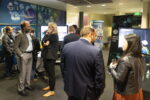Agents for growth: Turning AI promise into impact
As CEOs and CMOs ask where AI is moving from hype to real results, frontrunners demonstrate that tighter human–AI collaboration and sharper governance is required. A global retailer sees demand for a top product surge in one region while inventory piles up in another. Within seconds, a team of AI agents reallocates ad spend, adjusts pricing, reroutes stock, and refreshes creative assets to offers that match shopper intent. In this scenario, what comes next is coordinated action triggered by customer signals, orchestrating business growth in real time. This is not a fantasy scenario; it’s the new frontier of AI in growth functions. Agentic AI embeds automated reasoning directly into marketing, sales, and customer service workflows. We estimate that agentic AI will power more than 60 percent of the increased value that AI is expected to generate from deployments in marketing and sales. It’s no exaggeration to say that marketing and sales represent the tip of the spear when it comes to translating agentic AI’s potential into meaningful value. Early leaders are already seeing measurable impact. For example, according to McKinsey analysis, some Fortune 250 companies have estimated that they are seeing campaign creation and execution speed up 15-fold, driven by faster innovation cycles and process optimisation. The value from agentic AI comes from the tasks it is able to do. Unlike gen AI and chatbots that largely assist in the completion of marketing and sales tasks, AI agents can act, decide, and collaborate. They are able, for example, to optimize prices, advance leads, tailor offers and manage customer interactions end-to-end. As organisations deepen their adoption of agentic AI, gains can scale. Analysis shows that effective and scaled agent deployments could deliver productivity improvements of three to five percent annually and potentially lift growth by 10 percent or more. Most organisations, however, […]









